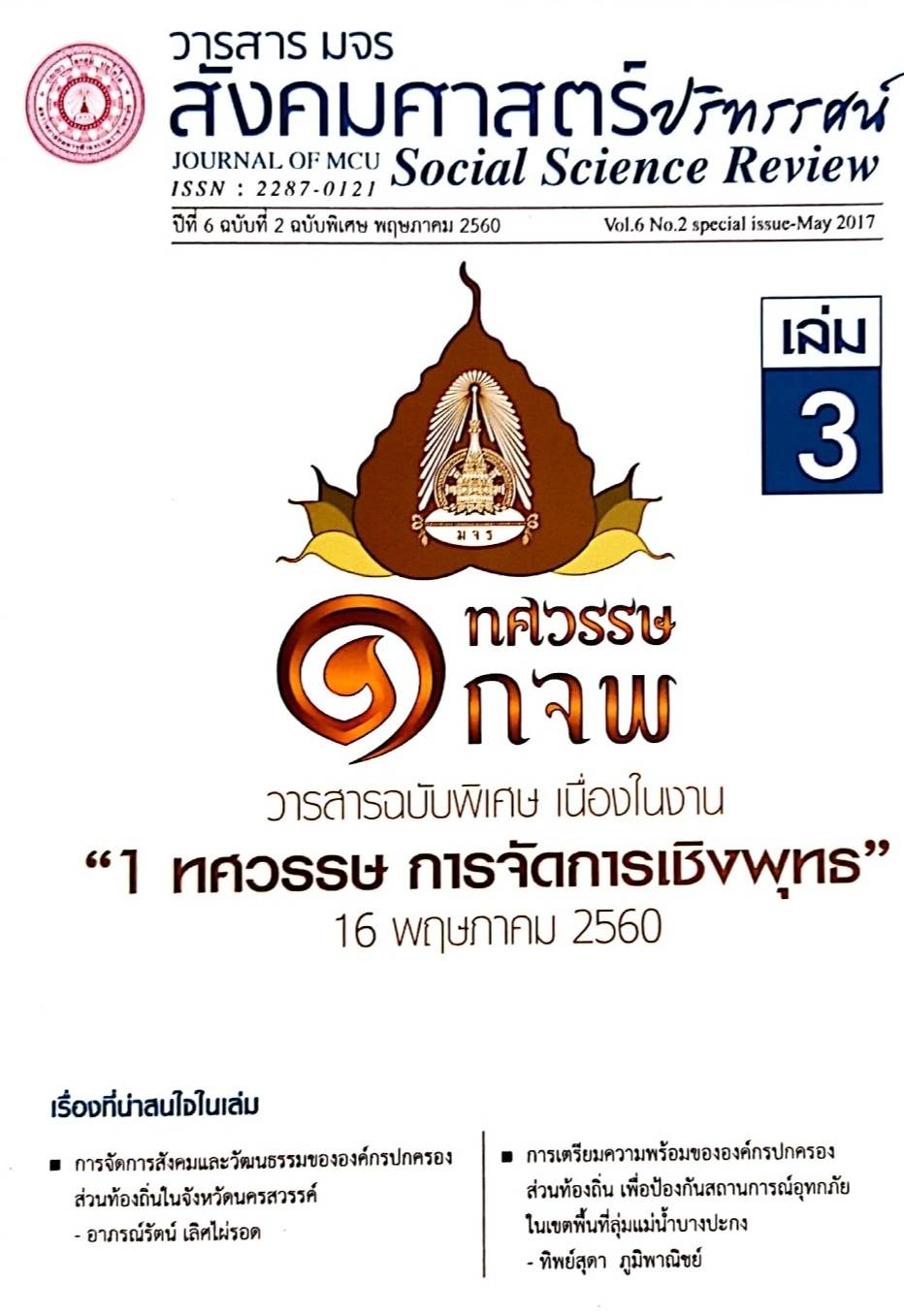การอนุรักษ์สิ่งแวดล้อมในพระพุทธศาสนา
บทคัดย่อ
การศึกษาวิจัยเรื่อง “การอนุรักษ์สิ่งแวดล้อมในพระพุทธศาสนา” มีวัตถุประสงค์ 2 ประการ คือ 1) เพื่อศึกษาแนวคิดเกี่ยวกับสิ่งแวดล้อมในพระพุทธศาสนา และ 2) เพื่อศึกษาแนวทางการอนุรักษ์สิ่งแวดล้อมในพระพุทธศาสนา โดยเป็นงานวิจัยเชิงคุณภาพจากพระไตรปิฎกและเอกสารทางวิชาการที่เกี่ยวข้อง สรุปได้ดังนี้
ผลการศึกษาแนวคิดเกี่ยวกับสิ่งแวดล้อมในพระพุทธศาสนา พบว่า สิ่งแวดล้อมในพระพุทธศาสนา คือ คำว่า “บริวาร” หมายถึง สิ่งที่อยู่รอบตัวมนุษย์ ซึ่งแบ่งเป็น 2 ประเภท คือ (1) สิ่งแวดล้อมทางธรรมชาติ ได้แก่ (1.1) สิ่งแวดล้อมทางธรรมชาติที่ไม่มีชีวิต ได้แก่ อุตุนิยาม และ (1.2) สิ่งแวดล้อมทางธรรมชาติที่มีชีวิต ได้แก่ พีชนิยาม จิตนิยาม กรรมนิยาม และธรรมนิยาม (2) สิ่งแวดล้อมที่มนุษย์สร้างขึ้น ได้แก่ (2.1) สิ่งแวดล้อมที่เป็นรูปธรรม คือ ศาสนสถานและศาสนวัตถุ และ (2.2) สิ่งแวดล้อมที่เป็นนามธรรม คือ วัฒนธรรมประเพณี กฎระเบียบ แนวทางการอนุรักษ์สิ่งแวดล้อมในพระพุทธศาสนาแบ่งออกเป็น 2 แนวทาง คือ (1) แนวทางการอนุรักษ์สิ่งแวดล้อมภายนอกตามหลักสัปปายะ 7 คือ การพัฒนาสถานที่ให้เป็นที่สบาย 7 ด้าน คือ 1) อาวาสสัปปายะ (ที่อยู่อาศัยเป็นที่สบาย) 2) โคจรสัปปายะ (แหล่งอาหารเป็นที่สบาย) 3) ภัสสสัปปายะ (ถ้อยคำเป็นที่สบาย) 4) ปุคคลสัปปายะ (บุคคลเป็นที่สบาย) 5) โภชนสัปปายะ (อาหารเป็นที่สบาย) 6) อุตุสัปปายะ (อุณหภูมิเป็นที่สบาย) และ 7) อิริยาบถสัปปายะ (การเคลื่อนไหวเป็นที่สบาย) และ (2) แนวทางการอนุรักษ์สิ่งแวดล้อมภายในตามหลักภาวนา 4 คือ การฝึกอบรมตน แบ่งออกเป็น 2 แนวทาง คือ (2.1) แนวทางการอนุรักษ์สิ่งแวดล้อมทางกาย ได้แก่ กายภาวนา และสีลภาวนา และ (2.2) แนวทางการอนุรักษ์สิ่งแวดล้อมทางจิต ได้แก่ จิตตภาวนา และปัญญาภาวนา โดยมุ่งหมายเพื่อการพัฒนาวัดให้เป็นปฏิรูปเทส
เอกสารอ้างอิง
ดำรงราชานุภาพ. (2513). สมเด็จพระเจ้าบรมวงศ์เธอ กรมพระยา. ตำนานพระพุทธเจดีย์. พระนคร : ศิลปาบรรณาคาร.
ป. ปลงสมบุญ. พจนานุกรม มคธ-ไทย. พิมพ์ครั้งที่ 2. ม.ป.ท.. ม.ป.ป..
ปิ่น มุทุกันต์. (2549). มงคลชีวิต. พิมพ์ครั้งที่ 6. กรุงเทพมหานคร : สร้างสรรค์บุ๊คส์.
พระธรรมกิตติวงศ์ (ทองดี สุรเตโช). (2548). คำวัด. กรุงเทพมหานคร : เลี่ยงเชียง.
พระธรรมปิฎก (ป.อ.ปยุตโต). (2545). พจนานุกรมพุทธศาสตร์ ฉบับประมวลธรรม. พิมพ์ครั้งที่ 11. กรุงเทพมหานคร : บริษัท สหธรรมิก จำกัด.
พระพรหมคุณาภรณ์ (ป.อ. ปยุตฺโต). (2551). พจนานุกรมพุทธศาสตร์ ฉบับประมวลธรรม. พิมพ์ครั้งที่ 16. กรุงเทพมหานคร : บริษัท เอส. อาร์. พริ้นติ้ง แมส โปรดักส์ จำกัด..
พระพุทธโฆสเถระ. (2548) .คัมภีร์วิสุทธิมรรค. แปลและเรียบเรียงโดย สมเด็จพระพุฒาจารย์ (อาจ อาสภมหาเถร). พิมพ์ครั้งที่ 6. กรุงเทพมหานคร : ธนาเพรส.
พระเมธีธรรมาภรณ์ (ประยูร ธมฺมจิตฺโต). (2538). ธรรมะกับการอนุรักษ์สิ่งแวดล้อม. กรุงเทพมหานคร : บริษัทสหธรรมิก จำกัด.
พระศรีคัมภีรญาณ (สมจินต์ สมฺมาปญฺโญ). (2554). สารนิพนธ์พุทธศาสตรบัณฑิต ประจำปี 2554. กรุงเทพมหานคร : โรงพิมพ์มหาจุฬาลงกรณราชวิทยาลัย.
พระสัทธัมมโชติกะ ธัมมาจริยะ. (2539). ปรมัตถโชติกะ ปริเฉทที่ 9 เล่ม 1 สมถกรรมฐานทีปนี. พิมพ์ครั้งที่ 4. กรุงเทพมหานคร : โรงพิมพ์ทิพยวิสุทธิ์.
มหาวิทยาลัยมหาจุฬาลงกรณราชวิทยาลัย . (2539). พระไตรปิฎกฉบับภาษาไทย. กรุงเทพมหานคร : โรงพิมพ์มหาจุฬาลงกรณราชวิทยาลัย.
สมเด็จพระมหาสมณเจ้ากรมพระยาวชิรญาณวโรรส. (2543). วินัยมุข เล่ม 3 (หลักสูตรนักธรรมชั้นเอก). พิมพ์ครั้งที่ 31. กรุงเทพมหานคร : มหามกุฏราชวิทยาลัย.
องค์การสหประชาชาติ. (2548). 60 ความสำเร็จขององค์การสหประชาชาติ. กรุงเทพมหานคร : องค์การสหประชาชาติ.
ดาวน์โหลด
เผยแพร่แล้ว
รูปแบบการอ้างอิง
ฉบับ
ประเภทบทความ
สัญญาอนุญาต
ลิขสิทธิ์ (c) 2020 วารสาร มจร สังคมศาสตร์ปริทรรศน์

อนุญาตภายใต้เงื่อนไข Creative Commons Attribution-NonCommercial-NoDerivatives 4.0 International License.
เพื่อให้เป็นไปตามกฎหมายลิขสิทธิ์ ผู้นิพนธ์ทุกท่านต้องลงลายมือชื่อในแบบฟอร์มใบมอบลิขสิทธิ์บทความให้แก่วารสารฯ พร้อมกับบทความต้นฉบับที่ได้แก้ไขครั้งสุดท้าย นอกจากนี้ ผู้นิพนธ์ทุกท่านต้องยืนยันว่าบทความต้นฉบับที่ส่งมาตีพิมพ์นั้น ได้ส่งมาตีพิมพ์เฉพาะในวารสาร มจร สังคมศาสตร์ปริทรรศน์ เพียงแห่งเดียวเท่านั้น หากมีการใช้ภาพหรือตารางหรือเนื้อหาอื่นๆ ของผู้นิพนธ์อื่นที่ปรากฏในสิ่งตีพิมพ์อื่นมาแล้ว ผู้นิพนธ์ต้องขออนุญาตเจ้าของลิขสิทธิ์ก่อน พร้อมทั้งแสดงหนังสือที่ได้รับการยินยอมต่อบรรณาธิการ ก่อนที่บทความจะได้รับการตีพิมพ์ หากไม่เป็นไปตามข้อกำหนดเบื้องต้น ทางวารสารจะถอดบทความของท่านออกโดยไม่มีข้อยกเว้นใดๆ ทั้งสิ้น





